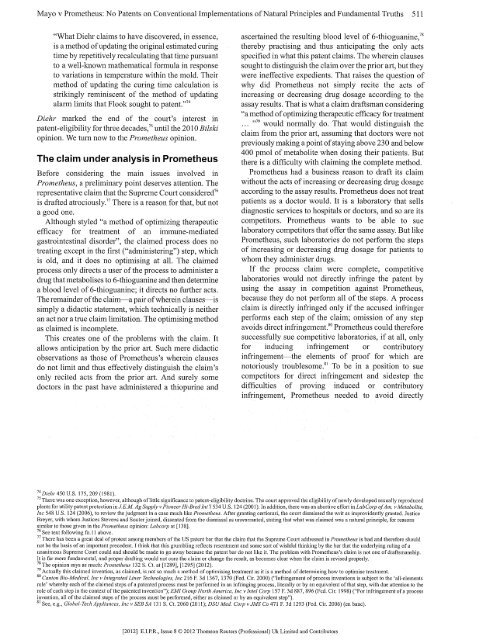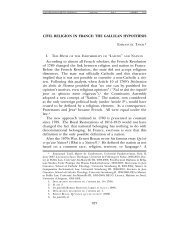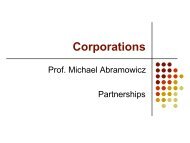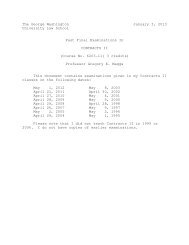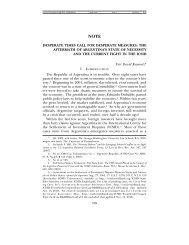Mayo v Prometheus - Gwu - George Washington University
Mayo v Prometheus - Gwu - George Washington University
Mayo v Prometheus - Gwu - George Washington University
Create successful ePaper yourself
Turn your PDF publications into a flip-book with our unique Google optimized e-Paper software.
<strong>Mayo</strong> v <strong>Prometheus</strong>: No Patents on Conventional Implementations ofNatural Principles and Fundamental Truths 511<br />
"What Diehr claims to have discovered, in essence,<br />
is a method of updating the original estimated curing<br />
time by repetitively recalculating that time pursuant<br />
to a well-known mathematical formula in response<br />
to variations in temperature within the mold. Their<br />
method of updating the curing time calculation is<br />
strikingly reminiscent of the method of updating<br />
alarm limits that Flook sought to patent." 74<br />
Diehr marked the end of the court's interest in<br />
patent-eligibility for three decades," until the 2010 Bilski<br />
opinion. We turn now to the <strong>Prometheus</strong> opinion.<br />
The claim under analysis in <strong>Prometheus</strong><br />
Before considering the main issues involved in<br />
<strong>Prometheus</strong>, a preliminary point deserves attention. The<br />
representative claim that the Supreme Couti considered 76<br />
is drafted atrociously. 77 There is a reason for that, but not<br />
a good one.<br />
Although styled "a method of optimizing therapeutic<br />
efficacy for treatment of an immune-mediated<br />
gastrointestinal disorder", the claimed process does no<br />
treating except in the first ("administering") step, which<br />
is old, and it does no optimising at all. The claimed<br />
process only directs a user of the process to administer a<br />
drug that metabolises to 6-thioguanine and then detennine<br />
a blood level of 6-thioguanine; it directs no further acts.<br />
The remainder of the claim-a pair of wherein clauses-is<br />
simply a didactic statement, which technically is neither<br />
an act nor a true claim limitation. The optimising method<br />
as claimed is incomplete.<br />
This creates one of the problems with the claim. It<br />
allows anticipation by the prior art. Such mere didactic<br />
observations as those of <strong>Prometheus</strong>'s wherein clauses<br />
do not limit and thus effectively distinguish the claim's<br />
only recited acts from the prior art. And surely some<br />
doctors in the past have administered a thiopurine and<br />
ascertained the resulting blood level of 6-thioguanine, 78<br />
thereby practising and thus anticipating the only acts<br />
specified in what this patent claims. The wherein clauses<br />
sought to distinguish the claim over the prior art, but they<br />
were ineffective expedients. That raises the question of<br />
why did <strong>Prometheus</strong> not simply recite the acts of<br />
increasing or decreasing drug dosage according to the<br />
assay results. That is what a claim draftsman considering<br />
"a method of optimizing therapeutic efficacy for treatment<br />
••• " 79 would normally do. That would distinguish the<br />
claim from the prior art, assuming that doctors were not<br />
previously making a point of staying above 230 and below<br />
400 pmol of metabolite when dosing their patients. But<br />
there is a difficulty with claiming the complete method.<br />
<strong>Prometheus</strong> had a business reason to draft its claim<br />
without the acts of increasing or decreasing drug dosage<br />
according to the assay results. <strong>Prometheus</strong> does not treat<br />
patients as a doctor would. It is a laboratory that sells<br />
diagnostic services to hospitals or doctors, and so are its<br />
competitors. <strong>Prometheus</strong> wants to be able to sue<br />
laboratory competitors that offer the same assay. But like<br />
<strong>Prometheus</strong>, such laboratories do not perform the steps<br />
of increasing or decreasing drug dosage for patients to<br />
whom they administer drugs.<br />
If the process claim were complete, competitive<br />
laboratories would not directly infringe the patent by<br />
using the assay in competition against <strong>Prometheus</strong>,<br />
because they do not perfonn all of the steps. A process<br />
claim is directly infringed only if the accused infringer<br />
performs each step of the claim; omission of any step<br />
avoids direct infringement. 80 <strong>Prometheus</strong> could therefore<br />
successfully sue competitive laboratories, if at all, only<br />
for inducing infringement or contributory<br />
infringement-the elements of proof for which are<br />
notoriously troublesome. 81 To be in a position to sue<br />
competitors for direct infringement and sidestep the<br />
difficulties of proving induced or contributory<br />
infringement, <strong>Prometheus</strong> needed to avoid directly<br />
74 Diehr 450 U.S. 175, 209 (1981).<br />
75 There was one exception, however, although oflittle significance to patent-eligibility doctrine. The court approved the eligibility of newly developed sexually reproduced<br />
plants for utility patent protection in J.E.M. Ag Supply v Pioneer Hi-Bred Jut '1534 U.S. 124 (2001 ). In addition, there was an abortive effort in LabCOJ]J of Am. v Metabolite,<br />
Inc 548 U.S. 124 (2006), to review the judgment in a case much like <strong>Prometheus</strong>. After granting certiorari, the court dismissed the writ as improvidently granted. Justice<br />
Breyer, with whom Justices Stevens and Souter joined, dissented from the dismissal as unwananted, stating that what was claimed was a natural principle, for reasons<br />
similar to those given in the <strong>Prometheus</strong> opinion: Labcmp at [ 138].<br />
76 See text following fn.l1 above.<br />
77 There has been a great deal of protest among members of the US patent bar that the claim that the Supreme Court addressed in <strong>Prometheus</strong> is bad and therefore should<br />
not be the basis of an important precedent. I think that this grumbling reflects resentment and some sort of wishful thinking by the bar that the underlying 1uling of a<br />
unanimous Supreme Comi could and should be made to go away because the patent bar do not like it. The problem with <strong>Prometheus</strong>'s claim is not one of draftsmanship.<br />
It is far more fundamental, and proper drafting would not cure the claim or change the result, as becomes clear when the claim is revised properly.<br />
78 The opinion says as much: <strong>Prometheus</strong> 132 S. Ct. at [1289], [1295] (2012).<br />
79 Actually this claimed invention, as claimed, is not so much a method of optimising treatment as it is a method of determining how to optimise treatment.<br />
8° Canton Bio-Medical, Inc v Integrated Liner Technologies, Inc 216 F. 3d 1367, 1370 (Fed. Cir. 2000) ("Infringement of process inventions is subject to the 'all-elements<br />
rule' whereby each of the claimed steps of a patented process must be performed in an infringing process, literally or by an equivalent of that step, with due attention to the<br />
role of each step in the context of the patented invention"); EMf Group North America, Inc v Intel Cmp 157 F. 3d 887, 896 (Fed. Cir. 1998) ("For infringement of a process<br />
invention, all of the claimed steps of the process must be performed, either as claimed or by an equivalent step").<br />
81 See, e.g., Global-Tech Appliances, Inc v SEB SA l3l S. Ct. 2060 (2011); DSU Med. Cmp v JMS Co 471 F. 3d 1293 (Fed. Cir. 2006) (en bane).<br />
[2012] E.J.P.R., Issue 8 © 2012 Thomson Reuters (Professional) Uk Limited and Contributors


